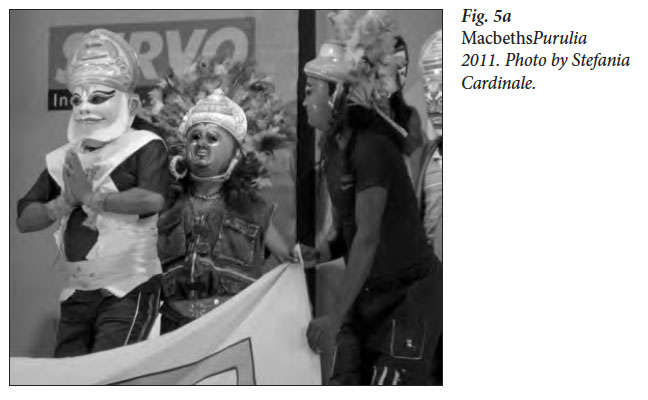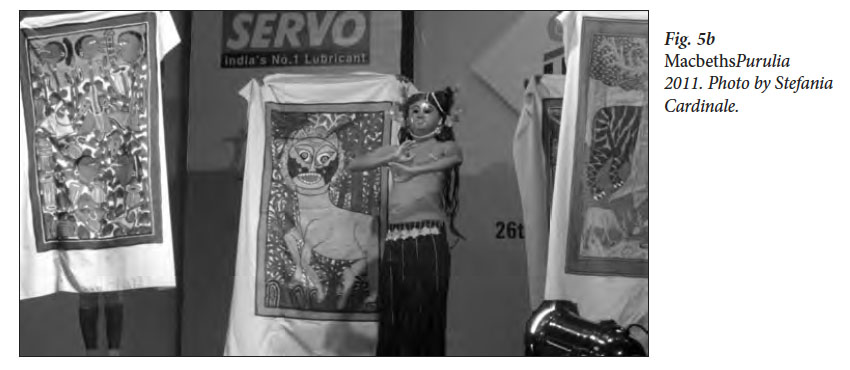Articles
Intangible Cultural Heritage Revitalization for Development and Tourism:
The Case of Purulia Chhau Dance
Abstract:
UNESCO’s recent Conventions (2003 and 2005) take intangible heritage’s potential into account through integrating cultural expressions, practices and traditions into development frameworks. However, how this integration should happen in the realm of the practice and what impacts would result from it is crucial in defining also the safeguarding of intangible heritage. This article will investigate how the intangible cultural heritage (ICH) of Chhau dance of Purulia India, was accommodated in a development project. A critical examination of actors involved and actions of the project, through an actor-network perspective, will discuss what this meant in relation to the heritage. The article highlights that the actions of integrating intangible heritage into a development project framework translated into the revitalisation of the cultural element, considered an outdated cultural product in need of modernisation. To what extent has the traditional form of art changed in line with project and development expectations?
Résumé
Lorsque le patrimoine immatériel intègre les marchés et le niveau international, il se produit des problèmes d’interprétation des patrimoines locaux. À partir d’une étude de cas, cet article présente l’histoire des praticiens de la danse Chhau et leur relation à la modernisation dans le cadre du projet Art pour vivre [Art for livelihood] en Inde. Cet article met en évidence les opinions des acteurs dans le cours de ce projet qui aboutit à faire coexister différentes « identités » du patrimoine Chhau pour des audiences différentes – locale, internationale et liste de l’UNESCO. La théorie de l’acteur-réseau confère son armature à cette étude de cas qui permet d’analyser de façon critique la compréhension des points de vue des acteurs et du déséquilibre des relations.
1 In recent years, culture has become a promising sector in which governments and international institutions invest in order that such development can be sustained. A target date of 2015 for achieving anti-poverty objectives known as the millennium development goals (MDGs) saw member states of United Nations (UN) working with member governments to integrate culture into their agenda. However, the MDGs failed to take into account the role of politics in culture and new post-2015 MDGs sustainable development goals (SDGs) still have not explicitly included culture (De Beukelaer 2015). Finally, culture has formally entered the development debate through the UNESCO Conventions (cf. UNESCO 2005).
2 The shift from economic-based development to culture-focused development can be traced to UNESCO’s vision of the potential for the development of culture found within the first Convention for the Protection and Promotion of the Diversity of Cultural Expressions (2005) and the previous (2003) Convention on Intangible Cultural Heritage1. Particularly the latter marked the role of intangible cultural heritage (ICH) in people’s lives:
3 Until this 2003 Convention, the international community of member states within the UN had not perceived culture as holistic and that the instruments of protecting culture, such as the World Heritage Convention (1972), were mainly related to tangible cultural expressions. Since then, not only ICH was institutionally judged to deserve equal attention as monuments or sites, but in several ways ICH gained momentum not only in the work of UNESCO, but also within World Tourism Organisation (WTO) and European Commission’s2 investments for cooperation and development (Jeretic, 2014; De Beukelaer 2015).
4 From October 28 to December 10, 2013, UNESCO hosted an open exhibition at their headquarters in Paris to commemorate the ten-year anniversary of the 2003 Convention. This exhibition featured examples of ICH from Brazil, Egypt, Estonia, Kenya, Samoa, and Spain, illustrating the contribution of intangible heritage to sustainable development. The UNESCO media service reported that communities employed ICH not only as a factor in tourism but also “to tackle everything from food scarcity and environmental change to health problems, education or conflict prevention and resolution” (UNESCO 2012).
5 The Art and Livelihood (AL) project implemented in India was a pilot project born in this framework of culture for development and it was financed by European Commission. The project attempted to develop creative livelihoods from folk arts of rural West Bengal (India), to boost tourism processes and socioeconomic development. This mechanism foresaw that the accumulation of benefits among stakeholders created the condition for tradition bearers to sustain their family, perpetuate their folk art as well as to invest funds in the village.
6 The development project prospective was also thought of as a safeguarding measure for intangible heritages endangered by the poor living condition of their bearers. In fact, in the area of the project, six districts of Purulia, Nadia, Bankura, Malda, Purba, and Pachim Medinipur in West Bengal, people are very poor, frequently suffering from drought and high rate of unemployment (Banik et al. 2004). The project was initiated by a social enterprise3 from West Bengal which, since 2004, began working in this area, with different projects of social and economic development. Later, in 2010, the biennial AL project—financed by European Commission and supported by UNESCO Delhi—aimed to enhance the livelihood status of 3,200 folk artists from rural West Bengal while revitalizing and promoting their endangered ICH. The folkloric arts involved in the projectwere: patachitra, singing stories painted on scrolls; baul and fakiri, Sufi music of Bengal; jhumur, tribal lifestyle music and dance; chhau, a combination of martial arts, masked dance and theatre; gambhira and domni, folk theatre forms. This paper reports on the case of Purulia chhau dancers under the AL project and on how a successful international cooperation project directed toward development and creative livelihoods for tourism translated into a revitalization and modernization of the cultural element. Actor-network theory is used as analytical lens to analyze the development and subsequent translation of the intangible heritage of chhau in the project network.
7 The ethnographic fieldwork I conducted for this paper looked at the project at the community level. This case study will highlight the extent to which “actors” in the project network accommodated their diversity of knowledge and roles to suit trends of the project and to the culture-for-development model of the project. In this project, “actors”—in Actor-Network Theory (Latour 2005; Law 1997; Callon 1986) may refer to people or objects—are chhau artists, UNESCO, the social enterprise leading the project, researchers, documents, masks, instruments, costumes and the stage, where dancers perform, to mention just a few. I will present how they entered the AL project network and worked for project aims with shared or opposing visions. As I will show, some negotiation of certain traits of the intangible heritage of chhau dance was unavoidable, and occurred in the name of a revitalization for a more “marketable” heritage. Actors all came to the project driven by different interests (popularity, economic, passion, personal interests). Their involvement in the project process necessarily had consequences on the transmission and dissemination of chhau identity, such as the creation of staged chhau stories and artifacts (mask and costumes).
Tourism and Development
8 Let me begin by outlining the connection between development, cultural tourism and ICH.
9 Scholars have long debated the link between tourism and development. Boissevain (1977) began to study tourism as a factor of development in Malta when the debate addressed mainly macroeconomic aspects of tourism (Baretje 1980; Jafari 1979; Mann 1985a, 1985b). An increasing number of studies are concerned with tourism-related challenges of fighting poverty and creating a more sustainable world. Among those studies is the well-documented capacity of tourism to contribute to the creation of economic development and social improvement in poorer communities (Hall 2007; Chok, Macbeth and Warren 2007; Harrison 2008; Goodwin 2008). The issue of tourism as a tool for communities became central to the “pro-poor tourism” approach, which fosters a form of tourism, intended to benefit especially poor people. This is particularly evident in the UN’s approach to tourism where it is stressed that tourism has the capacity to create infrastructures, develop skills and modernize communities. In 2001, the UN General Assembly recognized tourism’s role as a “positive instrument towards the alleviation of poverty and the improvement of the quality of life for all people” (A/RES/56/212 UN Resolution 2001) and it predicted tourism being particularly relevant in developing countries.
10 Similarly, a guide prepared by the WTO indicates tourism development as a tool to improve rural livelihoods, create mutual understandings and respects, pride and cultural awareness (WTO 2005).
11 Nevertheless, anthropological studies have challenged the idea that tourism promotes equal and social development and argued divergent positions regarding the role of tourism development and its consequences for local communities, particularly the viability of their cultural heritage. In literature, the phenomena of globalization and the consequent sophistication of the consumption of tourism products, has shifted attention onto the tourism effects with a growing reflexivity around the tourism action (Pritchard et al. 2011). Goodwin (2008) and Ashley et al. (2001) have advocated for a more attentive and empowering process of tourism in rural and poor communities to reduce risks of exploitation because, particularly when it comes to cultural tourism,4 this could be a means of translating cultural traditions or heritages into a commodity.
12 Cultural heritage has a role in identity formation and in strengthening national and local culture, but it is also, as previous research on tangible heritage demonstrated, an exploitable resource for the tourism industries (cf. Hughes 2000; Smith 2006; Park 2011). The moment a culture is defined as an object of tourism its authenticity is in danger (Taylor 2001). As with the case of the Maasai, of Tanzania, local participants (the host communities) in the tourism process regarded to tourism were also “a negative influence on their community well-being and tradition” (Buzinde et al. 2013: 14). Thus, cultural tourism development indeed can be seen as a form of dependence in developing countries (Britton 1989; Mowforth and Munt 1998), between the host communities and the hosted, where the foreign dominance of the tourism management and its “embedded concerns of development and dependency” (Selwyn 1994: 34).
13 From the perspective of local development instead, cultural heritage plays a role in the development process “not just by commodification of heritage resources for display and representation” in museums (Galla 2002: 63). Revitalization and replenishment of cultural heritage, as Galla suggests, can help local communities face the challenges of globalization while taking advantage of new opportunities for strategic partnerships in exploring the economic dimension of heritage conservation in sustainable development (Galla 2002). Other critical analyses of relationships between local and global levels contest the idea that the “flow of power” under tourism development is only one way: for instance, Du Cros and McKercher suggested that “cultural tourism development contributes to overall quality of life at the four levels of community: neighbourhood, local, national, and international” (2015: 6). In these perspectives, locals are not “passive” actors as seen in Cameron (1997), Milne (1998), Shaw and Williams (1998) and Cole (2007). They can negotiate and be resistant to changes imposed by tourism and markets in the pursuit of their interests and rights. However, the open question is: how does this “negotiation” happen in the practice and what impact would result on the intangible cultural element?
14 Recently the WTO released a baseline study that reported the links between tourism and intangible heritages, exploration of the elaboration, management and marketing of ICH for tourism in different projects and the concept of “good practice” relating to cultural tourism. The study reported intangible heritage tourism as a “powerful incentive since the revenue it generates can be channelled back into initiatives to aid its [ICH] long-term survival” (WTO 2012: 1). It also acknowledged that due to the fragility of ICH, safeguarding has to be a priority in intangible heritage tourism practices (WTO 2012). However, the WTO did not report either the impacts or micro-level effects of the actions and negotiations.
15 This issue is particularly relevant for this paper and our case study. Tradition bearers of a listed intangible heritage5, as chhau artists, may face a difficult decision concerning decisions on how and what to preserve of their intangible heritage. Considering the presence of external actors, as intermediaries of an international development project (social enterprise, international organisations, UNESCO representatives, researchers, new tourists, project partners, UNESCO nominations and ICH experts) working for and around their heritage, it is therefore crucial that tradition bearers have the ability to participate in the implementation of the process, as decision maker and director of the action.
Positioning the Investigation: An Actor-network Approach
16 This article acknowledges that writing about a developmental action, such as investigating the AL developmental project, is a delicate cultural operation (Li 1999: 298; Mosse 2005: 46). It has to be sensible to all the different parts of the process. When development relies on cultural tourism actions, particularly those involving ICH, the complex relationship between ICH and cultural tourism is further complicated by considerations of viability of intangible expressions, professionalization of tradition bearers, and artists’ and practitioners’ priorities. Although research on these subjects is growing, little research attempts to reveal the challenges of working with ICH in a development project perspective. In order to fill this gap while also trying to be sensitive to the complex dynamics around ICH, this paper attempts to look at the project, highlighting people, materials and discourses around the beneficiaries of the initiative and their heritage. Thus, the Actor-network Theory (ANT) proposed in 1986 by Latour offers a suitable lens of analysis for this case study.
17 An ANT approach offers a fresh horizon in tourism studies where it is still largely debated whether or not tourism studies require new conceptual approaches and methodologies (Cohen and Cohen 2012; Ren, Pritchard and Morgan 2010). Tourism studies have moved from examining the host-tourist relationship to examining the process of putting cultural tourism in place. Certainly Ren, Pritchard and Morgan have ignited a decisive turn in tourism studies examining issues of network of relationships that embody the tourism development process. Hence, tourism research and its production of knowledge should be seen as a “mutable and relational working,” in which the “power of relationships” is the main object of study (Ren, Pritchard and Morgan 2010: 886).
18 This research is also influenced by researchers as Jóhannesson (2005), Paget, Dimanche and Mounet (2010), Rodger, Moore and Newsome (2009), Tribe (2010), and van Der Duim (2007) who also applied ANT to tourism research case study.
19 ANT is sensitive to the process and ongoing dynamics, descriptions of the constant workings and effects, the heterogeneity of actors, whether human or not, and materials and practices. The first instance of ANT is indeed that action is not seen as “a property of humans but of an association of actants” (qtd. in Ren 2011: 861) and thus “actants” can be human or non-human. As already argued by Ren, non-human actors take place in tourism processes and partake the construction of tourism destinations (Ren 2011: 860). Masks, costumes and stages have a relevant role in chhau tradition and they influence and take place in the tourism development process of the project, as significant tools for interpreting the stories.
20 ANT will position the research to stress an insider’s perspective (actants’ perspective) offering a viewpoint association behind the practice, (in our case study the practice around ICH), as a contribution to the social anthropology of development and cultural tourism studies concerning ICH. Applying an ANT perspective to the project and chhau dance investigation will also contribute to the debate around safeguarding procedures by bringing out the micro-level dynamics and contested issues of practice.
Methodology
21 Latour (1999) argued that ANT is “simply another way of being faithful to the insights of ethno-methodology” (qtd. in Cressman 2009: 19; Law, Urry 2004). The line of ethnographic research in cultural studies, as Bendix (2009) suggests, can highlight and identify the key challenges that stakeholders face when dealing with safeguarding intangible heritage. In this study, it was particularly appropriate due to the complexity that arose when developing creative livelihoods for tourism through folk arts.
22 Qualitative methods dominated this study: unstructured interviews, participant observations, document reviews and field notes. The main data presented in this paper are from an ethnographic fieldwork conducted for four months in India in 2011, and in Europe (2011-2012). The key data analysis method used was discourse analysis, using QSR NVivo9 software to store and retrieve data through discourse and thematic analysis. NVivo software helps to handle qualitative data while also supporting an accurate and transparent data-analysis process of interrogation and coding. Excerpts of data from the fieldwork are presented below.
23 I chose to follow Mosse’s (2005) example of an anthropological examination with an ethnographic “actor-lead approach” to describe the internal and complex project (the ICH field and cultural tourism sector). This approach suggests considering practitioners (experts, social enterprise, UNESCO, artists) as well as materials (masks, costumes, stages, policy papers, and project papers) and artists, part of the web of powers of this specific process of revitalization of chhau heritage.
24 During the fieldwork, ethnographic work enabled me to observe interactions between the social enterprise and artists, and among artists and villagers, by allowing the emergence of unseen project constrains.
Actors as Respondents of this Study
25 ANT requires first of all the identification of actors as human and non-human “actants.” The human actors relevant for this study consisted of the social enterprise leading the project and chhau artists from Purulia, “beneficiaries” of the project. The latter are also referred to as artists. Other human actors were UNESCO representatives in India and project partners as well as villagers and researchers of ICH. The non-human actors included all the material artifacts and instruments used for the specific practice of the dance (masks, costumes, etc.), and those other material objects that served the project network, such as the project’s paper, the funds, video, promotional material, and the inscription file of chhau in UNESCO lists.
26 The creation of an actors-network occurs through layered assemblages and negotiations, a process of “translation,” which is described in Callon as a “definition and delineation of a scenario” where a complete transformation happens (Callon 1986: 25-26; Rodger, Moore and Newsome 2009). In our case study, the main transformation occurring through the project actor-network is the translation of the ICH of chhau.
27 According to Callon, who espoused actor-network theory along with Latour, description of the different phases of the network assemblage sheds light on the role of leading actor in the process (Callon 1986), other actors’ interests and goals, aligned with those of the leading actor (the social enterprise), and also on the point of controversy among them. For a matter of length, the descriptive account of the AL project actor-network won’t be covered in full in this paper, neither will do that of main actors, whose descriptive accounts have been already addressed in other papers (Cardinale 2015, 2016). In this paper attention is given particularly to the key actor of chhau dance and associations who were involved in the development and uptake of the revitalization of the cultural element.
Chhau Dance from Purulia: Traditional Dance and Intangible Heritage of the World
28 It is very difficult to capture the complexity of a dance that presents polysemic images like chhau. Detection of the meanings of dance steps and masks without recognizing the characters can be very challenging. Traditionally, chhau dance speaks to an illiterate Indian audience and has thus been developed to “speak with them without voice” (field notes 2011). Chhau language and themes are grounded in the iconographic art of West Bengal and in classical Indian literature. Favourite characters are those from Mahabharata or Ramayana, 6 —philosophical and devotional stories—but also from tribal literature portraying ideal characters (father, son, soldier, hero, etc.). (Fig. 1a; 1b). However, the key to attending a chhau performance is that the audiences must possess some knowledge about the story, recognize who the masks represent and know how the story ends.
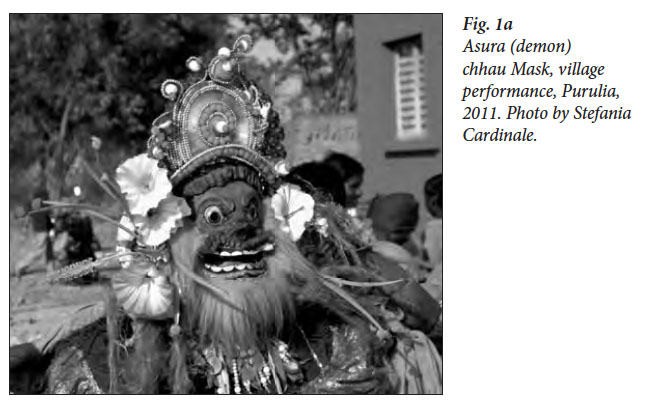 Display large image of Figure 1
Display large image of Figure 1
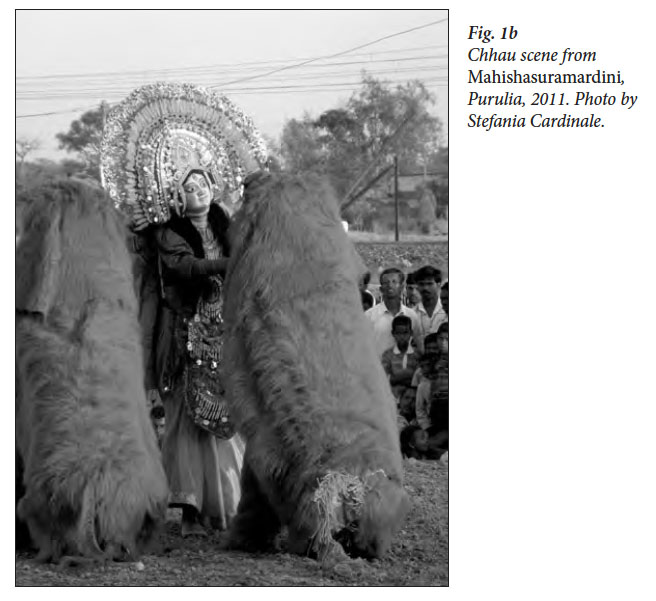 Display large image of Figure 2
Display large image of Figure 2
29 Chhau dancers perform stories from classical Indian epic, local heroic and tribal literature; however, any story to be “told (performed) must be in the chhau language and besides, it has to share some values with chhau” (Respondent no. 2). According to local artists, only someone who knows the chhau language (made of dance steps, gestures and specific feelings and values) can develop and direct new script for a chhau performance. When I was staying with artists in Bamnia village they taught me that when ustad (masters) develop stories for the group to perform they have to take into account scripts sharing feelings, values of pride and hero and stories that can be easily represented through the chhau. In an interview a local researcher passionate about this folk art reported:
30 Thus artists themselves they have to understand and “feel” the story as they own.
31 For years, artists have been performing in village streets and courtyards accompanied by Jhumur7 songs and music. The chhau show can last all night with two or three groups of ten to fifteen dancers each (depending on the festival, the stories and the contract) performing in a contest. Although originally “ekaira chhau” (the solo performance of the hero) was very famous, today Purulia chhau at the village level is more a group acrobatic and sometimes a synchronized theatrical dance. Artists move their body up and down on the ground. They make turns in the air and very acrobatic jumps with only knee or leg pads on and showing great athletic abilities. They perform wearing masks weighing as much as 8 kg (Fig. 2). Particularly in Purulia, masks define the way the body and steps are used to communicate the story and how values are transmitted to the audience. Masks are done according to the dancer’s face, concealing his identity. The character takes over the men when the artists enter the akhada (stage) (Fig. 3).
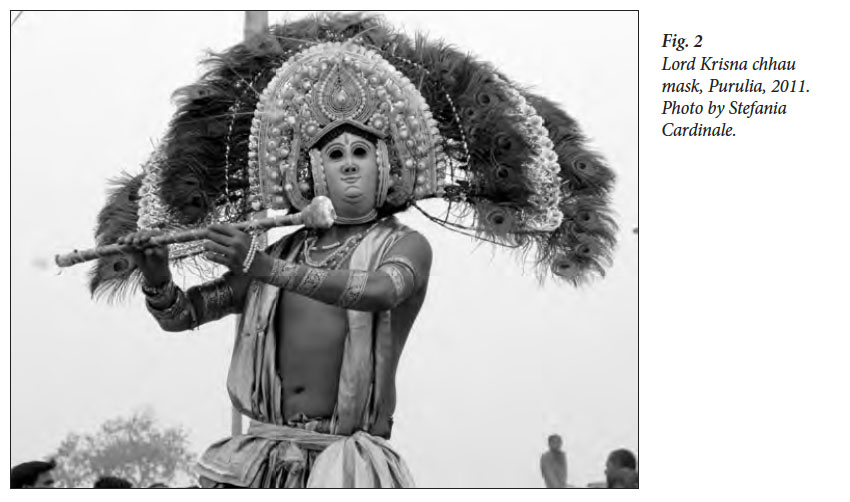 Display large image of Figure 3
Display large image of Figure 3
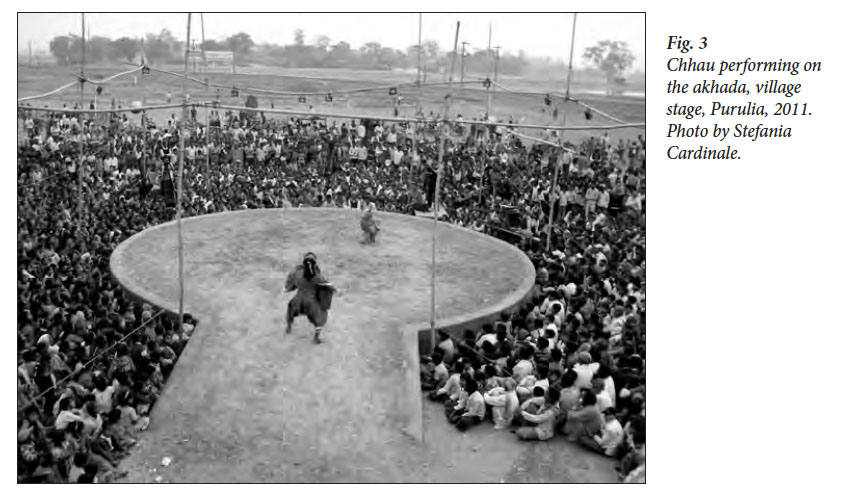 Display large image of Figure 4
Display large image of Figure 4
32 The dance has been known for its religious connotation (Bhattacharya 1989; Reck 1972; Chatterjee 2004). In April there is a period of pujas (Hindu rituals where people bathing, pray and gather in festivals), the Chaitra Parva. This period ends with four days of chhau festival dedicated to Shiva (God of destruction and reconstruction, of dance and war) and Shakti (Goddess of the Earth and active primordial energy). Traditional rural chhau is charged with an aura of belief to perpetuate the fertility of the Earth, and nowadays in rural areas of West Bengal, Bihar and Jharkhand, the dance is still performed during festivities, rituals, marriages or particular events and performers get paid for their exhibition (field notes 2011). However, literature about this folk dance is very skimpy and its origin is not really codified. For some scholars, the geographical inaccessibility of the remote forested area helped natives nourish their culture and costumes without outside influences for years (Bhattacharya 1989; Barba and Savarese 2005: 206). According to Bhattacharya, the origin of this folk dance stays mainly with musicians and drummers. Thus, initially shaped by the Dom—an outcaste highly educated group of soldiers and drummers—it slowly spread in the area and developed in three different styles today, each very distinct and linked to their territories. These different styles are grouped under the inscription of chhau dance among the heritage of the world.
33 Recently (2010), chhau gained the international recognition of “patrimony of the World” and was inscribed in the representative list of intangible heritage, by UNESCO (UNESCO 2010c).:
34 On the basis of the following traits, the ICH of chhau is formally recognized in the inscription file of UNESCO in 2010 as:
35 This nomination fostered the culturally distinctive aspects of the heritage embedded in the communities whose members partake in a common language and knowledge. Each chhau group includes dancers, guru or ustad (master), mask makers, musicians and instrument makers, costumes makers, singer or vocalist, helpers (dressers) and managers (Fig. 4). Being a chhau is a lifetime endeavour of training and engagement. Perfection for dancer is only reached with years of practice and, as artists stated, “not all the people can be chhau” (Respondent no. 1). Young men begin chhau training from the age of nine to ten years in families where the importance and pride of being a chhau is transmitted from father to son. Among beneficiaries of the AL project were Purulia chhau artists whose heritage resides in more than 100 groups of 15 to 30 members8.
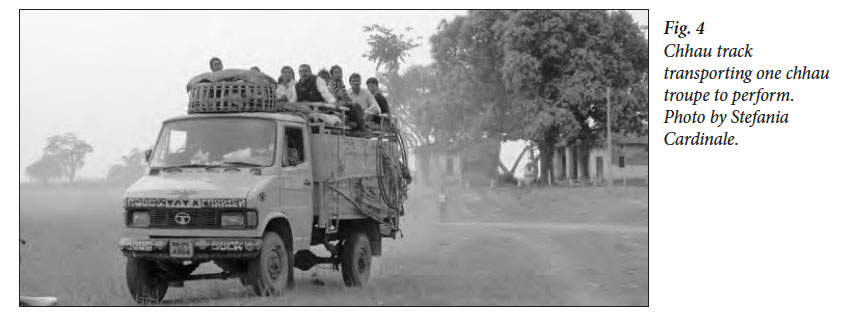 Display large image of Figure 5
Display large image of Figure 5
Revitalization for Development and Safeguarding: The Modernization and the Shakespearean Chhau
36 Safeguarding has become a priority for UNESCO and international governments who ratified the 2003 Convention for Safeguarding Intangible Heritage. It has entered academic discussions (Lira and Amoêda 2009; Smith and Agakawa 2009; Ruggles and Silverman 2009) and has begun to take a larger role in international cooperation. How exactly safeguarding can be articulated in practice is rather unclear and in need of research (field notes from the ICH Research Forum, 2012). The development project approach to safeguarding intangible cultural heritage with creative livelihoods stimulation must consider, for example: the risk of loss in traditional values, the importance of tradition bearers’ roles and interests in the process; the high risk of com-modification of the cultural element; or the risk of creating multiple representation of the cultural element, as this case study demonstrates.
37 In response to concern over the safeguarding of endangered intangible heritages around the world, UNESCO addressed this issue in the 2003 Convention on Intangible Cultural Heritage fostering different actions at national and international level. The 2003 Convention states that “‘safeguarding’ means measures ensuring the viability of the intangible cultural heritage, including the identification, documentation, research, preservation, protection, promotion, transmission, particularly through education, and revitalisation of the different aspects of such heritage.” However, revitalization and promotion carry various implications for the practices recognized as intangible heritage.
38 In just a few years, the social enterprise’s work has led to the development of cultural and creative tourism opportunities (i.e., local folk festivals; selling of artifacts; production of CDs; development of creative hubs) and to the revitalization of Purulia chhau dance for foreign audiences and international stages. Innovative strategies for the promotion, documentation, modernization, and training of the artists were fostered to enhance artists’ skills and ICH’s potential “as a social and economic capital” (field notes 2011).
39 The following section contains extracts from the empirical data leading to discussion of the revitalization of the cultural element with the “new artifact chhau” and to its conclusions.
Actions of Revitalization under the AL Project
40 Within the AL project network, chhau artists were involved in trainings and workshops to learn new techniques, to teach youth, to develop new stories and adapt the old one, to make their performance shorter, to create new and modern costumes and masks, to introduce new stories in their performance and also to partner with other artists, just to mention a few of the activities (field notes, 2011). Among the results of the multiple negotiations, new scripts for chhau stories were developed such as the Macbeth chhau based on Shakespeare, and old ones were revived and restructured such as the Blind Rish and the Kirat Arjun (these are basedon Indian literature by authors such as R. Tagore).
41 Macbeth chhau, for instance, was played on national and international stages during the project and soon after its end in 2011; however, it was met by the disappointment of many artists and local audience. An exhibition of Macbeth chhau took place in Kolkata in 2012, and a local journalist attending the event wrote in his article “the new avatar of traditional chhau dance, the martial folk dance of Bengal and Jharkhand ready for a global audience” (Chakraborty, Goodnewstab, January 7, 2012). A famous chhau mastercommenting on the new stories said “when locals engage my chhau group for festivals, they ask me not to bring the story of Tagore or Shakespeare” (Respondent no. 7). Locals indeed did not appreciate the changes proposed by the project and when inviting a chhau group to perform for a village festival or an event, they required them to perform the traditional chhau stories.
42 Some artists during interviews reported that they learned to reduce the time of their shows with the project’s workshops: Kirat Arjun’s show [for instance, was adapted during the project workshop] before lasted forty minutes, now is twenty (field note, 2011). Again they reported “We developed the story of Blind Rish with an external choreographer from the project, but the way we did it was not comprehensible to us or to local audience” (Respondent no. 2). Another artist reported, “The language 9 is a problem at local level. It has to remain the same we can’t change our language otherwise our community won’t understand our performance. But at national and international level maybe we can insert new developed stories” (Respondent no.7). The project negotiations undermined chhau’s identity as artists and some traditional traits. Therefore, at the time of my field work artists explicitly decided to perform new stories only at “formal” events linked to the project, and to avoid them at local events. Their reaction to the modern chhau was meant to preserving their identity and their fame.
43 The point of view of the social enterprise is significant to understand how it, as the project leader, positioned itself as decisive actor in fostering decisions about the revitalization of the intangible heritage:
44 This statement allows us to understand that some of the language aspects typical of chhau dance in Purulia—masks, costumes, dance steps, stories, roles and also the timing—were changed and renewed according to external and modern criteria, pushed by the project network. The power relationships inside the project actor-network prompt a cultural interaction between the rural and traditional chhau, the tradition bearers and its revitalization, with new developed stories, external choreographers, stories from Shakespeare and exchange with international artists.
Conclusion
45 ICHs are constantly changing and evolving with their bearers. As this paper shows, the ICH of chhau dance is also constantly constructed and re-constructed throughout workshops, events, international collaborations, and exchanges during all the AL project actor-network process (Cardinale 2015, 2016). It is translated in new artifacts used as a product of the project and aligned with various entities of the project (UNESCO, documents, stages, performers, instruments, international tourists, the social enterprise, etc.). However, although artists could negotiate and be resistant to changes imposed by the project’s goal, they (the artists) are also particularly susceptible to powerful changes in lifestyle and external influences (field notes 2011). During the project, artists performed globally and locally with increased revenues from their exhibitions. They were engaged in activities such as organizing festivals and mastering classes. So, the project has been successfully offering them more opportunities and developing a bunch of intangible heritage based livelihoods (Cardinale 2016).
46 Reactions to this revitalization of chhau dance under the project were, however, controversial. Artists expressed their will to stay enrolled in the project because they embraced the opportunities of incomes, recognition, new markets, tourism and partnerships. But an unavoidable negotiation of specific traits of chhau heritage seemed necessary for developing a more “marketable” heritage, a modern and contemporary chhau dance that could be adapted to different audiences. Revitalization of the dying folk dance therefore passed through actions for modernization and changes of the traditional culture (such as those seen in Macbeth chhau or in Blind Rish). These changes were considered appropriate to ensure understanding and appreciation of the chhau art by visitors and international audience and to make it viable. During the project process, the revitalization of the folk dance appears first as the result of a particular positioning of social enterprise’s leaders on a modern-like shaping of the folk art of chhau; secondly in its promotion with cultural tourism events and on international stages.
47 Tourism and development can be a powerful catalyst for revitalization of endangered intangible heritage in rural and poor areas around the World, even though it may also pose a danger to those cultural aspects that communities or tradition bearers wish to consciously protect from over-commodification and external interferences.
48 The actor-network informed this paper with a framework of analysis on the hidden mechanisms and power relationships; and it revealed how revitalization traded aspects of cultural identity for development. The analysis of the project demonstrates what “revitalization” can mean in the realm of the practice; it also showed that the international development project approach is inadequate when development runs contrary to ICH and UNESCO’s primary mandate on the protection of cultural identity.
49 As seen in this case study, the process of working on ICH for creating creative livelihoods should be sensitive to the possibilities of meeting with creating a proliferation of the representation of the heritage itself (i.e., Purulia chhau and Macbeth chhau) (Cardinale 2016). Project practices that engage “safeguarding” ICHs with activities of revitalization and revival of the cultural element while producing development should be responsible, by being particularly aware of the changes that any action of revitalization can produce on ICH and its cultural communities. The open question is: to what extend revitalization of intangible heritage enables reshaping local identity?
50 The intangible heritage seen from a subjective perspective of the actors ensures the connection between past and future and at the same time, it is a visible component of the present of rural areas, being perceived as the main source of identity, as well as a source of socio economic proliferation, being perceived as livelihood. Given that the intangible heritage under the pressure of globalisation and socioeconomic changes in rural areas, such as Purulia, is among the main human development goals, I consider that its sustainable valorization represents the duty of the present world.
